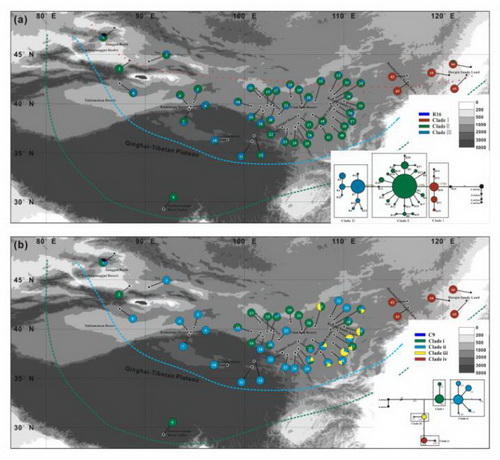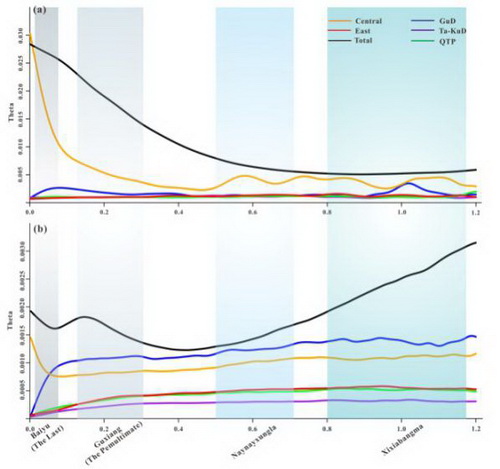Global Climate Change Affects the Distribution Pattern and Population Dynamic History of a Desert Pioneer Plant
Updatetime:2016-05-30From:
【Enlarge】【Reduce】
The desertification of the Asian interior was one of the most striking results of climate change in the Northern Hemisphere during the Cenozoic era. In recent decades, more and more stratigraphic investigations have proved that the desertification and its reverse of Asian interior was associated with the phase changes of glacial and interglacial climate. However, little evidence was found so far from the large scale investigation of vegetation.
Recently, from the molecular phylogeographic perspective, a team headed by Prof. MA Xiaofei from Key Laboratory of Stress Physiology and Ecology in Cold and Arid Regions, Chinese Academy of Sciences, clarified how the global climate change affected the population colonization, genetic differentiation, population dynamics and distribution range shift of Agriophyllum squarrosum, a pioneer annual plant endemic to mobile sand dunes of the Asian temperature deserts.
With a comprehensive survey in the species-wide distribution of A. squarrosum, a total of 188 individuals from 46 natural populations were sampled across all the deserts and sandy lands in the Asian interior, including the Taklamakan Desert, Gurbantunggut Desert, Kumutage Desert, Tengger Desert, Badain Jaran Desert, Qaidam Basin, Yarlun-tzanpo River Valley, Ulan Buh Desert, Kubuqi Desert, Mu Us Sandy Land, Horqin Sandy Land and Hunshandake Sandy Land.
Based on the genetic diversity of five maternally inherited chloroplast DNA (cpDNA) fragments and a bi-parentally inherited nuclear ribosomal internal transcribed spacer (nrITS) region, the molecular phylogeographic was reconstructed (Fig. 1), the population dynamic history (Fig. 2) and the distribution range shift in the past and future (Fig. 3) were simulated in this plant species.
The result of molecular clock showed that A. squarrosum could be originated from Gurbantunggut Desert since ~1.6 Ma, and subsequently have undergone three waves of colonization into other deserts and sandy lands corresponding to several glaciations. Compared to other populations, the rapid population expansion and distribution range shifts of A. squarrosum populations from monsoonal climate zones suggested that the development of the monsoonal climate significantly enhanced the population growth of A. squarrosum.
Furthermore, these data also suggested that desertification of the fragile grassland ecosystems in the Qinghai-Tibetan Plateau (QTP) was as earlier as 1.1 Ma, which was more ancient than eolian records. Under a warmer scenario in the near future, the habitat of A. squarrosum will expand into higher latitude and higher altitude regions of Asia and the QTP may also be at great risk of desertification.
From a molecular phylogeographic perspective, this endeavor will shed light on the current understanding of how desert ecosystems respond to changes in monsoonal climates, thus facilitating the evaluation of the ecological potential and germplasm resources of breeding candidate crops to manage the food supply in harsh environments.
This research is published on Scientific Reports (http://www.nature.com/articles/srep26613).
Contact:
Prof. MA Xiaofei
E-mail: maxiaofei@lzb.ac.cn
Key Laboratory of Stress Physiology and Ecology in Cold and Arid Regions, Gansu Province, Department of Ecology and Agriculture Research, Cold and Arid Regions Environmental and Engineering Research Institute, Chinese Academy of Sciences

Fig. 1 The distribution of haplotypes in the geological locations and Median-joining networks of the haplotypes in the 46 A. squarrosum populations examined in this study: (a) nrITS ribotype distribution and genealogy topology; (b) cpDNA chlorotype distribution and genealogy topology. (Image by Prof. MA)

Fig. 2 The dynamic changes of effective population size based on nrlTS(a) and cpDNA(b) (Image by Prof. MA)

Fig. 3 Predicted distributions of A. squarrosum in the present, past and future (Image by Prof. MA)
Appendix




